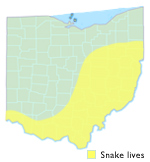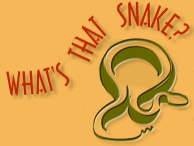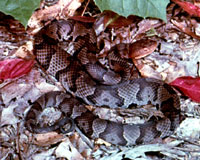WARNING!
The Northern Copperhead Snake is a very venomous snake. It is highly dangerous to people and their pets. If you think one of these snakes has bitten someone, seek medical help immediately.Latin name
Agkistrodon contortrix mokeson
Fast facts
Appearance
Range
Overall Range
Eastern United States, from southern New England westward through southern Pennsylvania, Ohio, Indiana and Illinois, and southward in the upland interior to northern Alabama, Georgia and South Carolina.
Range in Ohio
In Ohio this snake has been found in southern counties in the western half of the state, and in all but the northern counties in the eastern half.

Local Habitat
The Northern Copperhead lives in rocky and wooded parts of hilly and mountainous areas. It often is found in piles of rotting wood slabs or sawdust that remain from former sawmills. It often occurs on farms, and sometimes people find it in towns or cities.
Lifestyle
The Northern Copperhead Snake's coloration helps it with camouflage because it resembles fallen leaves and other debris on a forest floor.
Although shy and seldom seen, the native Northern Copperhead Snake has the "honor" of having bitten more people than any other venomous snake in the United States. However, there have been very few deaths attributed to its very painful bite. Still, this snake should be considered dangerous. When encountered, it will normally remain still or move away. If it feels very threatened, it will shake its tail and strike out in self-defense. The Northern Copperhead Snake has no rattle, but the sound of a vibrating tail in dry leaves may make a person think that this is a rattlesnake.
Northern Copperhead Snakes are gregarious. During the winter they hibernate with other snakes, sometimes even with other species of snake. As with many snakes, the Northern Copperhead Snake is diurnal in the spring and fall but becomes nocturnal during the summer. People sometimes see one of these snakes at night after a summer rain shower, lying on warm, wet road pavement.
More information

